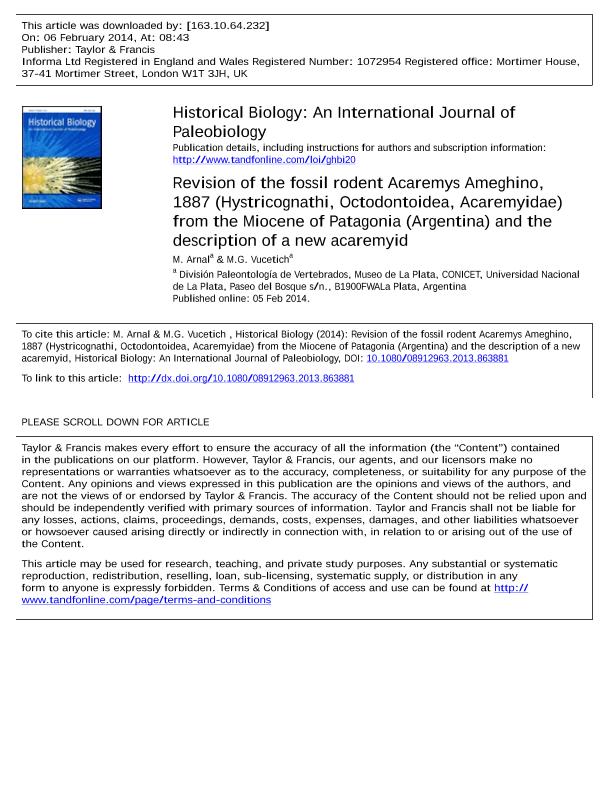Artículo
Revision of the fossil rodent Acaremys Ameghino, 1887 (Hystricognathi, Octodontoidea, Acaremyidae) from the Miocene of Patagonia (Argentina) and the description of a new acaremyid
Fecha de publicación:
01/2015
Editorial:
Taylor & Francis
Revista:
Historical Biology
ISSN:
0891-2963
Idioma:
Inglés
Tipo de recurso:
Artículo publicado
Clasificación temática:
Resumen
Within South American rodents, the Acaremyidae is an independent fossil lineage of octodontoids represented in the late Oligocene–middle Miocene of Patagonia. Acaremys is represented by six species recorded in the early Miocene, which have not been re-studied since their original description. Morphological and phylogenetic analyses suggest that Acaremys is paraphyletic. Three species are valid, Acaremysmurinus, Acaremysmajor, and Acaremysmessor. Acaremyskaraikensis is a junior synonym of Acaremysmurinus. ‘Acaremys’ tricarinatus is excluded from the genus being closely related to Sciamys. The new species, Pseudoacaremys kramarzi, is closely related to ‘Acaremys’ tricarinatus and Sciamys. ‘Acaremys’ preminutus is excluded from the family being closely related to the early Miocene Protacaremys prior, or living octodontoids. The phylogenetic analysis demonstrated that Acaremyidae includes Platypittamys, Galileomys, Acaremys, Pseudoacaremys and Sciamys. The new acaremyid increases the diversity of extinct octodontoids and added a new evolutionary lineage within Acaremyidae. The evolutionary history of the superfamily suggests that the hypsodonty and the consequently occlusal simplification evolved twice within Octodontoidea: in Acaremyidae and in Octodontidae. In addition, the cladistic analysis confirmed that most character ambiguities are due to missing data, and hence, it is essential to find better remains to elucidate the relationships among acaremyids.
Palabras clave:
Acaremys
,
Octodontoidea
,
Systematics
,
Santa Cruz Province
Archivos asociados
Licencia
Identificadores
Colecciones
Articulos(CCT - LA PLATA)
Articulos de CTRO.CIENTIFICO TECNOL.CONICET - LA PLATA
Articulos de CTRO.CIENTIFICO TECNOL.CONICET - LA PLATA
Citación
Arnal, Michelle; Vucetich, Maria Guiomar; Revision of the fossil rodent Acaremys Ameghino, 1887 (Hystricognathi, Octodontoidea, Acaremyidae) from the Miocene of Patagonia (Argentina) and the description of a new acaremyid; Taylor & Francis; Historical Biology; 27; 1; 1-2015; 42-59
Compartir
Altmétricas




